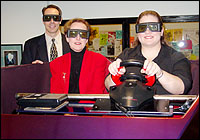Archives
UB researchers use virtual reality to treat car-accident survivors suffering from post-traumatic stress
By PATRICIA DONOVAN
Contributing Editor
Researchers from UB have developed a virtual-reality driving simulator that may help car-accident survivors recover from post-traumatic stress disorder (PTSD)—a prevalent, but commonly untreated condition associated with serious car accidents.
Eliot H. Winer, deputy director of UB's New York State Center for Engineering Design and Industrial Innovation (NYSCEDII), and his research team designed the two-seated simulator in collaboration with renowned PTSD researcher J. Gayle Beck, professor of psychology in the College of Arts and Sciences.

Checking out the simulator are,
from left, Eliot Winer of NYSCEDII; J. Gayle Beck, professor of
psychology, and Sarah Palyo, research assistant and doctoral student in
clinical psychology.
PHOTO: JOHN DELLA CONTRADA
The UB researchers are using the simulator to treat survivors of serious car accidents as part of a study to test its effectiveness as a therapeutic tool. Their goal is to develop a comprehensive treatment program using the simulator and make available virtual-reality software that can be used by therapists nationwide to treat car-accident survivors who suffer from PTSD.
"To be successful, you need a virtual-reality system that taps into the fear structure of the patient," Beck explains. "We've developed a very flexible software system that puts the patient in scenarios reminiscent of, or directly related to, their accident.
"We want to trigger their anxiety in a safe environment so we can help them overcome it."
The UB simulator and treatment system present the patient with a steering wheel, rear-view mirror and gas and brake pedals in a full 3-D world. The "car" is mounted on a motion platform that simulates the sensation of turning, braking and traveling up or downhill.
During therapy, the therapist "rides along" with the patient in the simulator's front passenger seat and inquires about the patient's anxiety level as he or she negotiates the virtual roadways. The therapist offers encouragement and suggests relaxation techniques when the driver encounters especially stressful traffic patterns or road conditions. As they drive, a library of virtual objects—including trees, houses, roads, streetlights and other cars—are presented in differing driving scenarios.
The therapist has complete control over driving conditions-changing the scenario from day to night and presenting the patients with various weather conditions. The therapist also can control the amount of traffic on the road and select urban or suburban driving scenes.
"As the simulation progresses, the entire driving environment is generated on the fly," says Winer, who led a team of UB students in development of the simulator. "We developed this automatic-generation capability to efficiently store all scene information so that patient and therapist can choose to return a previously visited location that may be critical to a patient's treatment."
"This capability could not have been developed were it not for the facilities and researchers at NYSCEDII," Winer adds. "This research center is developing state-of-the-art technologies not available anywhere, and this project is a prime example of that."
To date, there has been one other attempt by PTSD researchers to use virtual reality to treat car-accident survivors, notes Beck. That attempt may have failed because the VR simulation wasn't realistic enough and didn't present scenarios that closely match road and traffic conditions experienced by patients at the time of their accident, Beck says.
Currently, four car-accident survivors with PTSD are being treated using the VR system, according to Beck, who is recruiting 16 additional car-accident survivors from the Buffalo area to participate in the study. Each of the four was in a serious car accident within the past six months, and each is unable to drive on the roadways, except in "safe" environments-—such as their immediate neighborhood—or when they absolutely need to drive.
"Serious car accidents are perhaps the most commonly experienced traumatic events in the United States," Beck says. "The lives of accident survivors can be totally derailed by PTSD. They can't drive, they're obsessed with thoughts about the accident, they're depressed and they feel estranged from loved ones.
"If untreated, many PTSD sufferers develop a chronic form of the disorder that will persist throughout their lives," she adds.
Using the virtual-reality system, Beck and co-researchers gradually expose each patient to various driving scenarios, beginning with how to relax when first behind the wheel, and progressing to anxiety-producing scenarios particular to the patient's idiosyncratic fears, such as driving through a crowded intersection, over a bridge or on a highway with other drivers fast approaching from behind.
Without a VR simulator, PTSD treatment for car-accident victims typically involves mental visualization, talk therapy and gradual exposure to real driving situations. This process can be perilous for patients and other drivers on the road, Beck says.
"When PTSD drivers get behind the wheel, they're often so highly anxious that they're awful drivers," she explains. "They're constantly scanning the environment and doing all kinds of other safety behaviors that make them dangerous drivers.
"The VR simulator allows us to pace their exposure to driving, beginning with the simulator and then progressing to homework assignments involving real driving," she adds. "It gives the therapist the opportunity to safely monitor a patient's progress behind the wheel and really teach people what they need to do to overcome their anxieties."
Although the VR simulator treatment is experimental and may not be suitable for all drivers with PTSD, preliminary results of the study are promising, says Beck, who also is developing an innovative group-therapy program for car-accident survivors with PTSD.
"The more I've worked with this population, the more I've realized that these are people whom my field has ignored," Beck says. "The typical societal response to serious car-accident victims has been 'it's just a car wreck, get over it,' or they're viewed as malingers motivated by personal-injury lawsuits
"The VR simulator is one treatment venue that may help them overcome PTSD and get back to their normal selves."
